Introduction
I never knew grandfather, James Mildorf while he walked the earth. He lived on a farm in Baldwin County Alabama, about a 45- minute drive from the Gulf of Mexico, and I lived in suburban Milwaukee, Wisconsin. I saw him just once, in 1959, as he lay dying of cancer on a rickety old bed, in an ancient 2-room farmhouse that smelled of sickness and old wood. I remember that I thought he looked like Lincoln; his illness had carved his face into planes that reminded me of the gaunt look of the president in his last years. My grandfather was 72, and I was 6.
I did not guess then that James Mildorf and his wife Helen, nee Vandas, about whom I knew even less than I knew about James, would become heroic figures to me, for their determination and strength, hard work, courage, and persistence.
I owe any understanding of who my grandparents really were to my Aunt Lucille, the youngest of James and Helen Mildorf's four children. Aunt Lucille has a clear and quite amazing memory of her family and the years of their life together in rural Alabama. As the only living Mildorf of her generation, she is the main source of family lore for me.
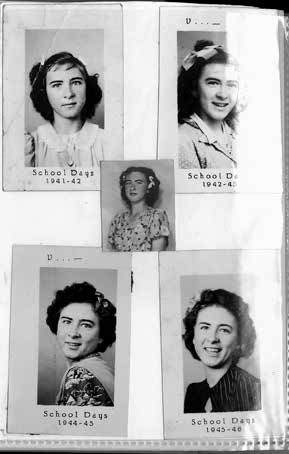
Lucille Mildorf Denham, "Aunt Lucille," school photo, Robertsdale, Alabama 1941-46. Photo courtesy of Lucille Denham.
Lucille Mildorf was born on the family farm just outside the city limits of Robertsdale. Robertsdale, Census Bureau 2013 population estimate, 5,671, 1 is midway between Mobile, Alabama and Pensacola, Florida, about an hour's drive from each.
For years, I thought of Aunt Lucille as a lovely phantom, my father Fred's youngest sibling and someone Dad spoke about with great love and tenderness. She was the thoughtful giver of a delightful little toy kitten that she sent me from Morocco when she and her Navy husband were stationed there. Later, she was the nice lady who lived in Jacksonville, Florida, whom we never saw. Then about 9 years ago, we began to correspond. The correspondence grew from polite notes and cards on special occasions to phone calls. The phone calls grew longer and more personal, and Aunt Lucille began to reveal to me who my grandfather was.
Czech genealogist Jan Dus researched my grandfather and his ancestors in the archives in the Czech Republic, while information gleaned from various official U.S. documents and websites filled in the rest.
Václav Mildorf's Early Days
My grandfather was born in Srbeč, Bohemia, a tiny town about 26 miles northwest of Prague, on February 24, 1887. Srbeč is a very old village; it was first mentioned in writing in 1227, when Pope Gregory IX confirmed possession of the monastery of St. George in Prague.2 The population of Srbeč today is 298.3
According to the research conducted by Jan Dus, Václav's father was Otakar Mildorf, "reservist of the 28th Battalion of the Third Companion, butcher and pub keeper," and his mother was "Anna, born Erbová, in Kalivody."4
My grandfather was baptized "Václav Mildorf," in a Catholic ceremony in Srbeč. He was the eldest of 5 children born to Otakar and Anna. Only 3 of the children survived to adulthood; the other 2, both daughters, did not live to see their first birthdays.
According to Aunt Lucille, my grandfather used to talk about how as a boy he loved learning and school, and he had a good mind. He had to set school aside, though, when his father died on July 28, 1899, of tuberculosis.5 Václav was 12 years old. As the eldest son, he had to go to work to support the family: his mother Anna, sister Anna Aloisia, and brother František.
He was apprenticed to a butcher and learned how to cut meat and make sausage. Life as an apprentice butcher and sausage-maker was not easy. Apprentices lived with the person under whom they were studying. Václav lived in a drafty attic above the butcher shop. Sometimes he would wake up in the morning with his bed covered in snow from the leaky roof. As an apprentice, he had to do all the grunt work. To get a cow, they had to find someone with a cow to sell. Someone had to walk to get the cow, and it might be many miles away. Václav would have to go and get the cow and lead it back to the butcher shop, which could be dangerous. He might not get back before dark, and someone might try to steal the cow along the way.
Coming to America
As Václav grew older, he became more and more dissatisfied with life in Bohemia. World War I was approaching, and he did not believe in fighting in Europe. He also found the social order stifling. Aunt Lucille notes that according to her father, the strict social hierarchy required people who were economically and socially in the "lower classes" to show respect for members of the "upper class". For example, in passing the home of a member of the upper class, the average man was expected to doff his hat, and the average woman was expected to curtsey. Possibilities for people of Václav's means to acquire land and make a future were limited. There also was the certainty of being conscripted into military service. Young men were required to serve in the military, and it was a harsh life. All of these considerations compelled Václav to come to America.
Getting out of Bohemia and the greater Austro-Hungarian Empire wasn't easy. He was poor, and it would take money to leave. It was a long way from landlocked Bohemia to a port that would give him access to a ship to America. He would have to take the train at least part of the way, and the authorities searched the trains, looking for young men trying to avoid the draft.
Václav knew that the lower-class cars on the trains were constantly monitored by the authorities looking for young men like him who were trying to leave the country, so he decided to travel in first class. Somehow Václav got on a train to Bremen. Somehow he got the money he needed for a first-class train ticket and ship's passage to America. He sailed from Bremen on the Cassel on April 11, 1907 and arrived at the port of Galveston, Texas on May 5, 1907.6 He was 20 years old.
When he arrived in America, Václav registered as "James Mildorf" and was "James" the rest of his life.
Coming off the ship at Galveston, the immigrants were covered with bed bugs. James found a room in a boarding house, and his landlady had him and the other immigrants give her their clothes, which she boiled to kill the bugs.
James's first job in America was as a cowboy. He worked on the Davis Ranch, a huge spread in Louis-Horton County, Texas. The ranch is still there; now it's called the "George Ranch." According to Aunt Lucille, you could ride straight from morning to night and still be on the ranch. James was one of about 15 cowboys. The Davis family, several brothers, owned the ranch. One of the brothers, a widower, had a little boy who was 6 or 7 years old. The boy liked to spend time with the cowboys. James befriended the boy, bought him a bag of candy from time to time and listened to the boy speak. That's how James learned English. We believe the photo below was taken at the Davis Ranch and shows James Mildorf and the boy who taught him English.
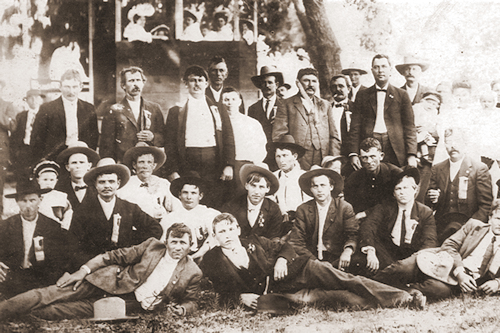
|
James Mildorf, third row from front, second from left and slightly behind little boy who we believe taught James English.
Click to Enlarge.
|
Aunt Lucille tells us that James was a teetotaler, and she tells the story of how that came to be. After his first pay day as a cowboy, James went into town with the other cowboys. He drank a little and shot up some mirrors and had to pay for them. This episode taught him that drinking didn't pay, so he didn't drink after that.
After his stint as a cowboy, James worked for a time as a surveyor along the Brazos River. James later told his daughter Lucille that a surgeon he knew in Texas told him to buy some land because it would be worth money someday. James didn't take this advice. I have to wonder how different his life and his descendants' lives might have been if he'd bought some of that land.
James was obligated to live in Texas for at least three years, under the terms of his sponsorship for arrival in the state. The details of how this came about are murky, but according to Aunt Lucille agents boarded the Cassel in Galveston, looking for strong men to work on the land and to increase the population of Texas in order to garner more representation in Congress. These agents provided "suitable" immigrants with the cash they needed to disembark. In return, the immigrants were required to reside in Texas for 3 years, until the next census was held. According to Aunt Lucille, after the immigrants made it through U.S. Customs, they had to give the money back to the agents.
To St. Paul and Beyond
After some years in Texas, James went to St. Paul, Minnesota. The 1910 Census data for the 11th Precinct of Ramsey County, Minnesota shows James living as a "boarder" and working as a "butcher" in a "meat market."
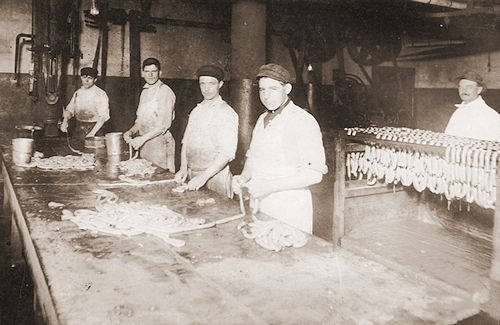
|
James Mildorf, second from left, working as a sausage-maker in St. Paul, Minnesota, around 1910.
Click to Enlarge.
|
While living in St. Paul, James met Helen Vandas, a young woman whose parents had come from Bohemia. How and where James and Helen met is a mystery, but we do know that they were married on September 1, 1913 in St. Paul, Minnesota, Helen's hometown.7 James was 26, and Helen was 22.
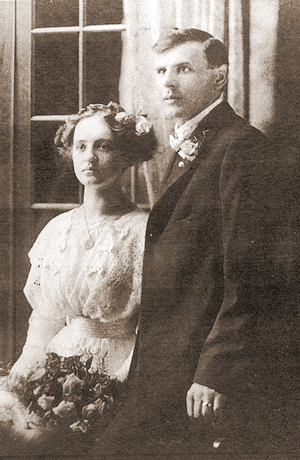
|
James and Helen Mildorf on their wedding day in St. Paul, Minnesota, September 1, 1913.
Click to Enlarge.
|
By 1920 James and Helen had moved to Wisconsin. The U.S. Census for 1920 shows them living in the town of Hackett, Price County, Wisconsin, with their daughter Marcella and sons Frank and Fred, my father. James' occupation is listed as "farmer."
My dad, Aunt Lucille and Uncle Frank always referred to the family home in Wisconsin as being located in Phillips. Perhaps they lived in both communities over time. It's also possible that since Phillips is much larger than the town of Hackett, the family, living in the country on a farm, associated themselves more closely with Phillips. While living in Wisconsin, James also worked in the cranberry bogs and the timber industry, according to Aunt Lucille.
Farming in Price County was hard work, especially on the rocky land. One day James was dynamiting rocks, to prepare some of his land for farming. He had set the charge, but it didn't go off. When he went to the spot to inspect it, the dynamite exploded, taking one of his eyes with it.
About 1920, James and Helen learned that there was affordable land in lower Alabama, plentiful and good for farming. Enticed by the ads and perhaps what they were learning from other Czechs who had made the move, James bought 160 acres just outside Robertsdale, Alabama, and the family left Northern Wisconsin for the Deep South.
Farming in Alabama
The piece of land James and Helen now owned in Alabama was partly rolling hills and partly low-lying swamp. The land had been farmed by a family who came before the Mildorfs, so some of it had been cleared. The rest was heavy with trees, especially pine trees. There was an old two-story wood frame house on the property, "Swedish Gothic" in style, according to my aunt, surrounded on the back and two sides by huge pecan trees that had already been there for perhaps a hundred years when the family arrived. At first the Mildorfs lived in the house, but it was so old and unstable that it was no longer safe, so the family tore it down and built a new house in its place. The new home was a simple two-room wooden house.
In the beginning of their life on the farm, the family got water by going down to the spring a long distance from the house, and drawing it up in buckets. Later they installed a hand pump in the house and built a pipe system that brought the water up from the spring.
The family experimented with various crops, including new vegetables and fruits that the county agricultural specialists suggested. These included at least two varieties of persimmons. The Mildorfs also tried experiments they devised themselves, such as growing and drying pumpkins. This particular endeavor was not one of their most successful.
Over time, the family became proficient in growing cucumbers and raising dairy cattle and chickens. By the 1930s, they had about 100 head of cattle and 400-500 chickens. They also had more than 100 pear trees. At harvest time, trucks would come down from Bay Minette, about 26 miles away, and go from farm to farm collecting the harvested, boxed pears, to take to market and to the processing plant.8
The Mildorfs had a smokehouse, and James butchered meat and made sausage for the family.
In later years, the Mildorf men constructed a sawmill on the place, with equipment purchased from fellow Czechs, the Heidelbergs in Silverhill.
Over time, there were two more children, a girl who was miscarried and Aunt Lucille, who was born in 1928.
In 1939 Helen died. She had been in the hospital for a relatively minor procedure when she developed a blood clot in her lung that took her life. By this time my father, Fred, had left home for St. Paul, where he worked, studied, and stayed with relatives. He would not return to live on the farm until the 1970s, after he became disabled in a construction accident.
In time, after Helen's passing, James bought an additional 60 acres of land, mostly low-lying and wet. World War II came, and both Frank and Fred joined the Army and served in Europe. Aunt Marcella married Tony Leiterman and moved a bit south, to a big farm in Elberta, Alabama. James and Lucille toiled alone on the farm, Lucille attending the local high school.
After the war, Frank came home to the farm. Lucille married a wonderful young Navy man, Glen Denham, whom she had written to during the war, as part of the home front's efforts to support the troops.
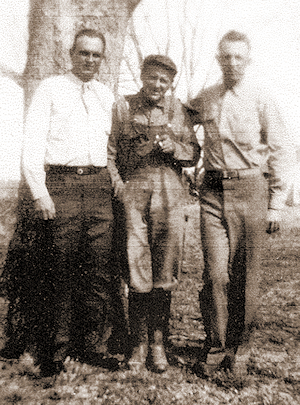
|
Left to right: Fred, James, and Frank Mildorf, on the family farm in 1945, when Fred and Frank returned home from WW II.
Click to Enlarge.
|
James and his son Frank lived on the farm in the little two-room wooden house until James' dying day, May 3, 1959.
Postscript
In May 2014, my husband Gary and I met a kind and gracious couple, Marion and Carolyn Arnould, while visiting Baldwin County. The Arnoulds' land borders the old Mildorf family farm. Marion knew my grandfather well. He told us that he never saw James wearing anything but overalls; James had only one good eye; and he frequently used colorful language. Marion also told this story: An itinerant Baptist preacher, Rev. J.S. Tumblin, was visiting Baldwin County in 1959. He was a man on fire with the Holy Spirit and preached a rousing sermon. He had been in the stock market and made, then lost a fortune. After he lost his material wealth, he felt the call to serve the Lord and became a preacher. He was particularly known for asking, as he traveled, whether there was anyone in the area who was sick, especially those nearing the end. Marion admired this preacher and spent quite a lot of time with him, and he took Rev. Tumblin to meet my grandfather. They found James very ill, in the little old house, with Frank devotedly attending him. The preacher asked to be alone with James, and Frank and Marion left James and Rev. Tumblin alone. They talked for quite a while, and as the preacher was about to leave, Frank went out to the chicken house, put some eggs in a bag and presented them to Rev. Tumblin in appreciation. Not long afterward, James passed away.
My grandfather's discontent in Bohemia led him to leave all that was familiar, to find a better life in America. His determination took him all the way from Srbeč to Texas to Minnesota, to Wisconsin and finally to the Gulf Coast of Alabama. I wonder if he was surprised by his adventures. I wonder if he found what he wanted when he came here. I like to think that someday when my days on earth are done, I'll see James Mildorf, and Helen too, and have the opportunity to ask them these questions.

This article was originally published in the Dec 2014, Vol. 26 No. 4 issue of Naše rodina, the quarterly publication of the Czechoslovak Genealogical Society International (CGSI), headquartered in Minneapolis, Minnesota. To learn more about CSGI and the many online resources and conferences they offer, visit www.cgsi.org
© Melda H. Boyd

About the Author:
Melda Boyd moved with her parents and siblings to the old family place in Baldwin County, Alabama in the early 1970s. She graduated from the University of South Alabama with a double major in International Studies and Russian.

Endnotes
1 U.S. Census Bureau website: www.census.gov/quickfacts
2 Website of the village of Srbeč, Czech Republic; http://www.srbec.cz/ Downloaded 3 August 2014.
3 http://www.srbec.cz/ Downloaded 3 August 2014.
4 State Archive in Praha; Roman Catholic Parish in Srbeč; Birth Register, Book #12, page #55-56,
record #5
5 Town Hall in Mšec; Roman Catholic Parish in Srbeč; Death Register, Book #4, page #21, record
#8.
6 Transcription of original ship's passenger list for the Cassel's voyage from Bremen to Galveston, 11 April 1907, downloaded from Die MAUS - Family History and Genealogical Society of Bremen, http://www.passengerlists.de/
7 U.S. Department of Justice; Immigration and Naturalization Service: Declaration of Intent No. 2833, signed by James Mildorf and Virgil C. Griffin, Clerk of the U.S. District Court, on 17 October 1941, Mobile, Alabama.
8 Interview with Lucille Mildorf Denham, January 2014, Middleburg, Florida.


|